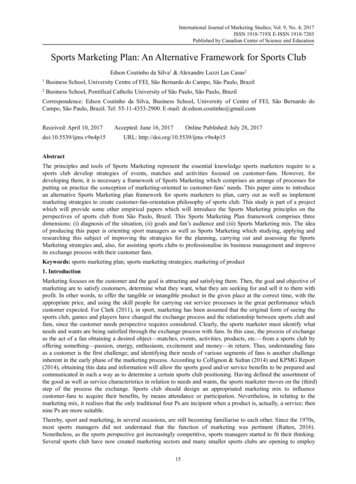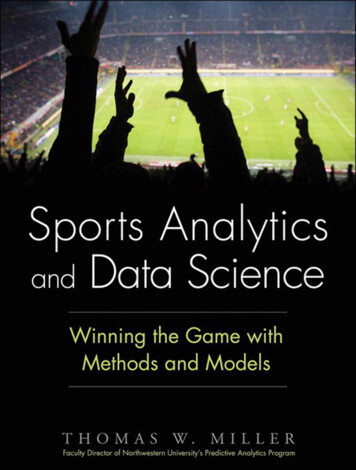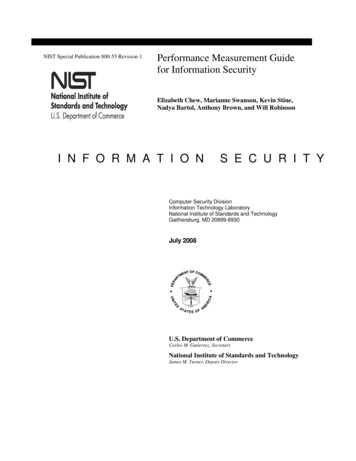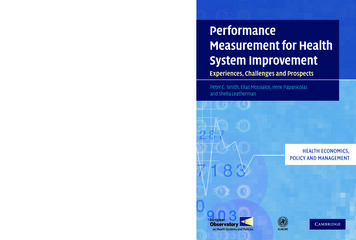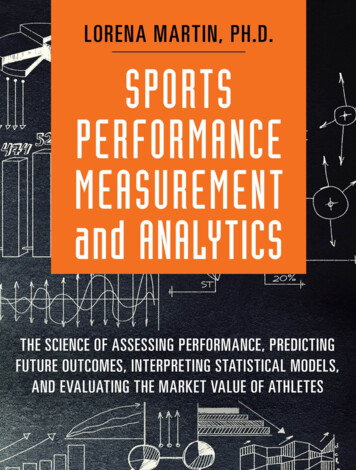
Transcription
Sports PerformanceMeasurement and AnalyticsThe Science of Assessing Performance,Predicting Future Outcomes,Interpreting Statistical Models,and Evaluating the Market Value of AthletesL ORENA M ARTIN
Publisher: Paul BogerEditor-in-Chief: Amy NeidlingerExecutive Editor: Jeanne Glasser LevineCover Designer: Alan ClementsManaging Editor: Kristy HartProject Editor: Andy BeasterManufacturing Buyer: Dan UhrigConsulting Editor: Thomas W. Millerc 2016 by Lorena MartinPublished by Pearson Education, Inc.Old Tappan, New Jersey 07675For information about buying this title in bulk quantities, or for special sales opportunities(which may include electronic versions; custom cover designs; and content particularto your business, training goals, marketing focus, or branding interests), please contactour corporate sales department at corpsales@pearsoned.com or (800) 382-3419.For government sales inquiries, please contact governmentsales@pearsoned.com.For questions about sales outside the U.S., please contact international@pearsoned.com.Company and product names mentioned herein are the trademarks or registeredtrademarks of their respective owners.All rights reserved. No part of this book may be reproduced, in any form or by anymeans, without permission in writing from the publisher.Printed in the United States of AmericaFirst Printing February 2016ISBN-10: 0-13-419330-XISBN-13: 978-0-13-419330-4Pearson Education LTD.Pearson Education Australia PTY, Limited.Pearson Education Singapore, Pte. Ltd.Pearson Education Asia, Ltd.Pearson Education Canada, Ltd.Pearson Educación de Mexico, S.A. de C.V.Pearson Education—JapanPearson Education Malaysia, Pte. Ltd.Library of Congress Control Number: 2015958702
tomy and Physiology2Assessing Physical Variables153Sport Psychological Measures414Selecting Statistical Models535Touchdown Analytics696Slam Dunk Analytics957Home Run Analytics1178Golden Goal Analytics1379Game, Set, Match Analytics157iii
ivSports Performance Measurement and Analytics10 Performance and Market Value173Statistics Glossary187Football Glossary193Basketball Glossary201Baseball Glossary209Soccer Glossary227Tennis Glossary241Bibliography247Index289
Preface“Impossible is just a big word thrown around by small men who find iteasier to live in the world they’ve been given than to explore the power theyhave to change it. Impossible is not a fact. It’s an opinion. Impossible is nota declaration. It’s a dare. Impossible is potential. Impossible is temporary.Impossible is nothing.”—M UHAMMAD A LII have played sports my entire life. I began playing the sport of tennis at theage of thirteen, too late in the eyes of many tennis experts to become a topprofessional tennis player. I trained six hours a day from the first day that Iwon a match against a boy at a neighborhood tennis court. In an instant, Iwas addicted to the sport.I dreamed of becoming a professional tennis player. I spent countless hourson the court, skipping hangouts, holidays, and dates just to hit tennis balls.I went on to play high school and college tennis. I dropped out of collegeto play professional tennis. I worked for an airline so I could travel inexpensively to compete in professional tennis tournaments around the world.Tournaments were (and still are) scattered across the globe, giving a personof lower socioeconomic status a very slim chance of making it. Throughmy tennis training and competition, I reached a Florida state ranking ofnumber three and a top 200 women’s professional ranking in the USA.As an undergraduate, I majored in psychology. I wanted to learn about thepsychological and behavioral profiles of successful professional athletes. Iwent on to get a master’s degree in psychology.v
viSports Performance Measurement and AnalyticsAfter studying psychology, I wanted to obtain a deeper understanding ofthe importance of physiology and physical fitness variables in sports, suchas muscular strength, power, endurance, anaerobic power, cardiorespiratory endurance, and flexibility. I felt it was essential to learn as much aspossible about the processes going on inside an elite athlete’s mind andbody. I earned a doctorate in exercise physiology from the University ofMiami and was recruited to conduct postdoctoral research in behavioralmedicine at the University of California, San Diego.I have always been driven to learn about statistics, about what is and is notbeing said by the numbers. I wanted to see which variables could be used topredict sport performance and to answer a simple question: “What are thequalities a person must have to become a world class athlete?” This question and many more may be answered through research, measurement,statistics, and analytics.I went on to teach research methods and statistical design at Florida International University. Later I joined Northwestern University, where Icurrently teach introduction to statistical analysis as well as sports performance analytics.As a teacher of sports performance analytics, I tried to find a book that encompassed sports-relevant anatomy and physiology and described athleticperformance measures. I wanted a book that included statistical analysesand models used in various individual and team sports, along with statistics adopted by the sports industry. But I found no such book.I chose to write this book to give athletes, coaches, and managers a betterunderstanding of measurement and analytics as they relate to sport performance. To develop accurate measures, we need to know what we wantto measure and why. This book provides new insights into constructs andvariables that have often been neglected in sports to this day. It also reviewsfundamentals of sports anatomy and physiology, sport measurement, andperformance analytics.This book serves many readers. People involved with sports, includingplayers, coaches, and trainers, will gain an appreciation for performancemeasures and analytics. People involved with analytics will gain new insights into sports performance and see what it takes to become a competitive athlete. And students eager to learn about sports analytics will have a
Prefacepractical introduction to the field. Data sets and programs in the book areavailable from the book’s website http://www.ftpress.com/martin/.Many thanks to Thomas W. Miller, my consulting editor, for making thisbook happen, as it would not have been possible to complete without him.And special thanks go to my editor, Jeanne Glasser Levine, and publisher,Pearson/FT Press, for giving me the opportunity to publish my first book.Of course, any writing issues, errors, or items of unfinished business aremy responsibility alone.I want to give a special thank you to my brother and professional tennisplayer, Juan J. Martin Jr., who constantly provides me with insightful information based on his experience in professional sports and exercise physiology. I would also like to thank the Dallas Cowboys’ Director of Football Research, Tom Robinson, for his instrumental remarks and comments. Thanksto Roy Sanford, a lead faculty member in Northwestern University’s Master’s Program in Predictive Analytics, who provided constructive critiqueson statistical methods. I want to thank my mother, Estela Martin, for beingthere day and night and offering continued support. Tambien, gracias a mipadre, Juan J. Martin Sr., for providing me with a sports-like motivation, impelling me to complete this book. In addition, I would like to mention mydogs, which are always there for me and brought a smile to my face whileworking on this book.Most of all, I want to thank God for making this possible.Lorena MartinSan Diego, CaliforniaDecember 2015vii
This page intentionally left blank
Cone Agility Drill by Player Position (NFL)20-Yard Shuttle by Player Position (NFL)Vertical Jump by Player Position (NFL)40-Yard Dash by Player Position (NFL)Broad Jump by Player Position (NFL)Bench Press by Player Position (NFL)Lane Agility Drill by Player Position (NBA)Bench Press by Player Position (NBA)Max Vertical Leap by Player Position (NBA)Standing Vertical Leap by Player Position (NBA)Three Quarter Sprint by Player Position (NBA)Shuttle Run by Player Position (NBA)Steals by Player Position (NBA)Defensive Rebounds by Player Position (NBA)Offensive Rebounds by Player Position (NBA)Assists by Player Position (NBA)Shooting Percentage by Player Position (NBA)Player Efficiency Rating by Player Position (NBA)Hits by Player Position (MLB)RBIs by Player Position (MLB)Runs by Player Position (MLB)Home Runs by Player Position (MLB)Number of Assists by Player Position (UEFA)Number of Goals Scored by Player Position (UEFA)Number of Passes Attempted by Player Position (UEFA)Number of Passes Completed by Player Position (UEFA)Professional Tennis Player Earnings by Nationality (ATP, WTA)Professional Tennis Player Earnings by Rank and Sex (ATP, 9109126126127127149149150150167168
This page intentionally left blank
62.72.82.92.102.113.13.23.34.14.25.16.17.1Types of BonesMuscles in SportCharacteristics of Fiber TypesMuscle Fiber Types and SportsRate/Capacity of Adenosine Triphosphate (ATP)Primary Energy System Duration and IntensityLimiting Factors for Energy SystemsAthletic Training and Energy SystemsPhysiological Markers of Athletic PerformancePhysical Measures and Fitness ModelsBody Fat Percentage CategoriesBody Mass Index (BMI) CategoriesBody Density Equations Used to Calculate Body Fat PercentageRepetition Maximum CoefficientsRepetition Maximum ValuesBody Muscle Group Testing for Athletes (Part 1)Body Muscle Group Testing for Athletes (Part 2)Range of Motion of Select Single-Joint Movements in DegreesESPN’s List of Ranking Sports by CoordinationSport-Specific SkillsSport Psychological Measures and FactorsDesirable Attributes of MeasurementsA Measurement Model for Sports PerformanceOverview of Statistical MethodsReview of Statistical Tests and ModelsFootball Performance MeasuresBasketball Performance MeasuresBaseball Performance 2566878103125
xiiSports Performance Measurement and 10.610.7UEFA Champions League Tournament Phase Leading ScorersUEFA Champions League Tournament Phase Leaders in AssistsSoccer Performance MeasuresTennis Performance MeasuresAnnual Cost for Playing Professional TennisAnnual Expenses for the 100th-Ranked Tennis PlayerU.S. Minority Group Income and EducationSalaries of Top MLB PlayersSalaries of Top NBA PlayersSalaries of Top NFL PlayersSalaries of Top ATP PlayersSalaries of Top WTA PlayersSalaries of Top MLS PlayersSalaries of Top FIFA Players146147148164165165166179180181182183184185
Exhibits5.15.26.16.27.17.28.18.29.19.2Analyzing NFL Combine Measures (R)Analyzing NFL Game Time Performance Data (R)Analyzing NBA Draft Data (R)Analyzing NBA Game Time Performance Data (R)Analyzing MLB Player Performance (R)Analyzing MLB Game Time Batting Performance (R)Analyzing UEFA Assists and Goals Scored (R)Analyzing UEFA Passes Attempted and Completed (R)Analyzing ATP and WTA Player Earnings by Country (R)Analyzing ATP and WTA Player Earnings by Rank and Sex (R)xiii8292110114128130151154169172
This page intentionally left blank
1Anatomy and Physiology“A muscle is like a car. If you want it to run well early in the morning, youhave to warm it up.”—F LORENCE G RIFFITH J OYNERUnderstanding the basics of anatomy and physiology is fundamental to obtaining a more comprehensive knowledge of what it means to be an athlete.Let us start by answering the question, “What is an athlete?” We can thinkof an athlete as a person who is skilled at a sport, trains, and possessesphysical attributes such as muscular strength, power, endurance, speed,and agility, to name a few.The physical attributes and variables of an athlete will be detailed and explained in chapter 2. This chapter focuses on the fundamental anatomy andphysiology of an athlete. The objective of this chapter is to help the sportsdata analyst, as well as athletes themselves, understand the human bodyand how its machinery functions during athletic events in order to comprehend how performance is affected by physiology. This chapter will openyour eyes to new ways of thinking about number crunching and sports analytics. Knowledge of the main physiological mechanisms will make you amore competitive and insightful sports data scientist.1
2Sports Performance Measurement and AnalyticsTable 1.1.Types of BonesType of BoneExample of BoneLong bonesFemur, Humerus, TibiaShort bonesTarsals of the foot, Carpals of the hand and wristFlat bonesScapula, Sternum, CraniumIrregular bonesVertebrae, Sacrum, MandibleSesamoid bonesKnee Cap, there are four sesamoid bones in the hand,there are two sesamoid bones in the footLet us review the basic bone structure and anatomical information youshould be aware of. The human body is made up of 206 bones and morethan 430 skeletal muscles. The topic of anatomy alone could take severalbooks to do it justice. We will cover the part of human anatomy and physiology most relevant to sports performance.The study of bones is called osteology. Osteologists dedicate their lives tounderstanding how bones function. Bones are responsible for providingconstant renewal of red and white blood cells, and are vital not only to ourorgans, but to gaining a competitive edge in sports performance. There areseveral types of bones: long bones, short bones, flat bones, irregular bones,and sesamoid bones. Long bones are associated with greater movementdue to the lever length, compared to short bones which have limited mobility, but are known to be stronger. Please refer to table 1.1 for examples ofeach type of bone.The musculoskeletal system is integral to human movement, as it is comprised of ligaments that connect bone to bone and tendons that connectmuscles to bone. Consequently, when the muscle pulls on the bone, motionoccurs. Depending on the method of classification or grouping, estimatesof the number of muscles in the body range between 430 to over 900. Infact, each skeletal muscle is considered an organ that contains muscle tissue, connective tissue, nerves, and blood vessels. Much of the debate is amatter of definition in terms of how the muscles are quantified.
Chapter 1. Anatomy and PhysiologyLike bones, muscles may be classified by type: smooth muscle is foundin the blood vessels and organs, cardiac muscle is found in the heart, andskeletal muscle is abundant throughout the human body and is responsiblefor our daily movement.Upper body muscles and muscle groups to become familiar with includethe latissimus dorsi, trapezius, deltoids, rotator cuff, pectorals, biceps, triceps, and brachioradialis. Midsection muscles involved in sports performance include the rectus abdominus, external and internal obliques, andthe transversus abdominis. Lower body muscles vital for many sports include the quadriceps, hamstrings, gluteus (maximus, minimus, medius),gastrocnemius, and the soleus. Please refer to table 1.2 for the locations ofthese muscles and their function in sports.Many of you have heard of fast twitch and slow twitch muscle fibers. Mostpeople are only aware of two fiber types, fast and slow, or white and red.However, it is much more accurate to say that there are hybrid fiber typesthat lie within the spectrum of Type I and Type II muscle fibers. More recently, the scientific field revealed three distinct categories of muscle fibers.These are Type I, Type IIa, and Type IIx muscle fibers. Type I fibers arecommonly referred to as slow-twitch while both Type IIa and Type IIx arerecognized as fast-twitch muscle fibers.To facilitate understanding, we will focus on the differences between TypeI and Type II because they are inherently different as they relate to the following characteristics: ability to utilize oxygen and glycogen as determinedby aerobic enzyme content, myoglobin content, capillary density, and mitochondria size and density.Typically, slow-twitch muscle fibers tend to be high in all the criteria mentioned above. In comparison, fast-twitch muscle fibers tend to be low inthese characteristics, while having greater nerve conduction velocity, speedof muscle contractility, anaerobic enzyme content, and power output. Fasttwitch fibers are known to have high glycolytic activity, meaning they utilize glycogen (the storage form of glucose, which many call sugar) at highlevels, whereas slow-twitch muscle fibers rely on their oxidative capacity.Please refer to table 1.3 for additional muscle fiber type characteristics.3
4Sports Performance Measurement and AnalyticsTable 1.2.Name of MuscleMuscles in SportLocation of MuscleFunction in SportLatissimus dorsilocated in the posterior part of the body,largest muscle group in the upper body,also called the backinvolved in extension and adduction of the shoulderas well as pulling motions; relevant for all sportsRhomboidslocated in the upper back underneath thetrapezius and consists of two muscles;rhomboid major and minorinvolved in retraction of shoulder bladesrelevant for all sportsTrapeziuslocated above and superficial to rhomboidsextends from shoulders to neck musclesinvolved in distributing loads away from the neckand keeping the shoulders stabilizedDeltoidscommonly referred to as the shouldersinvolved in throwing motionsused extensively in overhead athletesRotator Cufflocated in the shoulder area deep under thedeltoids, muscles that hold the shoulder in placeinvolved in throwing motions; quarterbacks,pitchers, and tennis players when servingPectoralscommonly referred to as the chestincludes pectoralis major and minorinvolved in chest press strength, and abduction ofthe shoulder and pushing movementsBicepslocated in anterior part of the arm and calledbiceps because of the two heads of the muscleinvolved in swinging motion; tennis playersforehand and baseball swings; also involved inbending of the elbow and for picking up motionsTricepslocated in posterior part of the arm and calledtriceps because of the three heads of the muscleextension of elbow; used to straighten the elbow;used in stiff-arm movement in football playersBrachioradialis andPronator Teresforearm musclesutilized in sports using the wristRectus Abdominuslocated in the anterior part of the bodyunder the abdomenutilized for flexion of the spineand core stabilization; relevant for all sportsExternal Obliqueslocated above and superficial to the internalobliques on each side of the trunkutilized for sideways bending and rotation of thetorso; integral for tennis strokesInternal Obliqueslocated underneath the external abdominaloblique on each side of the trunkutilized for flexion of the spine, sideways bending,trunk rotation and compression of the abdomen;relevant for all sportsTransversus Abdominislocated in the deepest layer of abdominal muscles utilized for respiration and core stabilization;that wraps around the torsorelevant for all sportsUpper Body MusclesCore and Midsection MusclesLower Body MusclesQuadricepslocated in anterior part of thigh consisting of fourmusclesresponsible for extension of the knee; major sourceof strength for soccer players; relevant for all sportsHamstringslocated in posterior part of thigh consisting ofthree musclesresponsible for flexion and bending of the knee;relevant for all sportsGluteus Maximus, GluteusMedius, and Gluteus Minimuslocated in the area usually called the buttocksutilized in explosive first step movements;integral for lower body strength and powerGastrocnemiuslocated in the lower leg area and typically referred utilized in jumping and tip-toe motions includingto as part of the calf musclebeing on the ball of your feetSoleuslocated in the lower leg
mance analytics. As a teacher of sports performance analytics, I tried to find a book that en-compassed sports-relevant anatomy and physiology and described athletic performance measures. I wanted a book that included statistical analyses and models used in various individual and team sports, along with statis-tics adopted by the sports industry.Cited by: 3Page Count: 48File Size: 1MBAuthor: Lorena Martin
